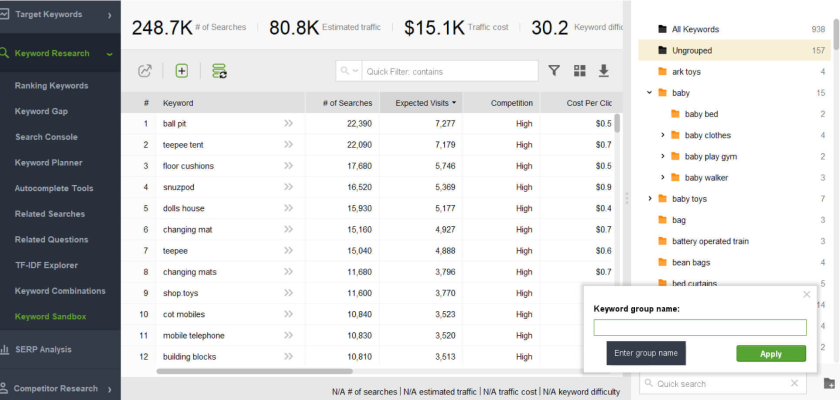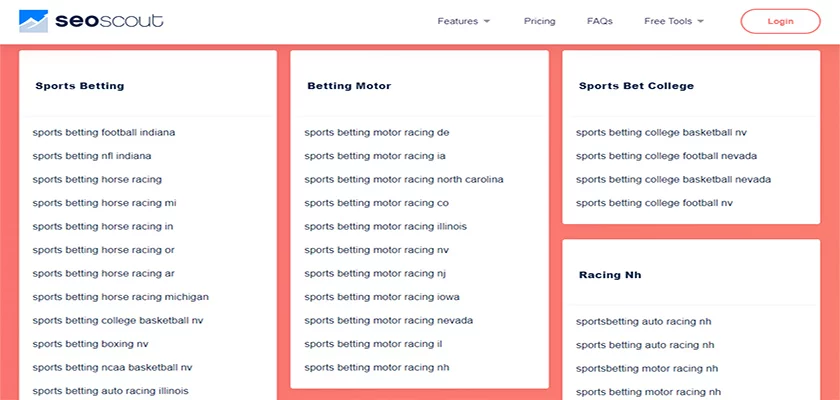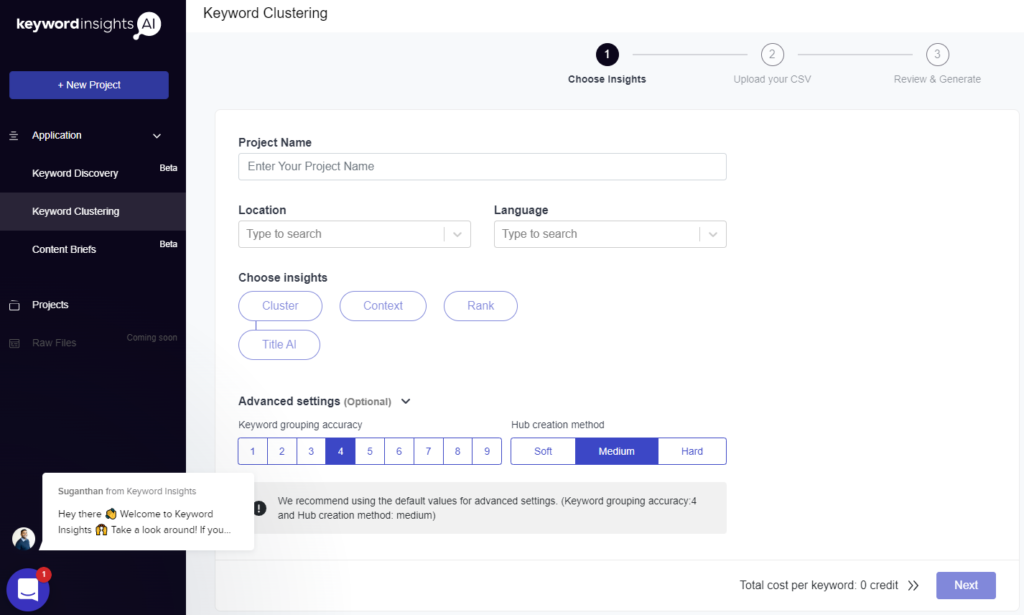
Ultimate Guide to Keyword Mapping: Tools and Strategies
Keyword mapping is the process of assigning keywords to the pages on your website. This procedure helps you carefully allocate keywords across your site so that they would bring most of the traffic and clicks.
Let’s have a look at why keyword mapping is what your SEO strategy has to start with, how to implement it correctly, and what tools will help you here.
Why do you need keyword mapping?
Keyword mapping helps refine your keyword strategy in many ways:
- Find keyword gaps. Your competitors may rank higher just because they use keywords that you don’t. Keyword mapping will help you identify those keywords and assign them to the relevant pages.
- Find keyword overlap. Keyword overlap happens when you target different keywords with the same pages. This results in lower rankings and even duplicate content issues. Keyword mapping will help you assign keywords to unique target pages so that they don’t steal each other’s traffic.
- Head users to the relevant information. Users need different content based on their search intent and the stage of the customer journey. Assigning keywords to pages based on their intent markers will help you cover the users’ needs and convert them.
Keyword mapping steps
Now let’s see what keyword mapping actually is, and look through the processes you’ll need to implement.
1. Do keyword research
First, you need to look to find all the keywords you already rank for and the new keywords you’re going to target.
You can check what keywords already bring you traffic with Google Search Console and discover new word ideas with Google Analytics, Keyword Planner, Google Trends, and any other keyword research tool you are using in your SEO routine.
Keep in mind that not all keywords are worth your attention, so filter them to exclude those with low traffic potential.
2. Group keywords by topic and search intent
Once you’ve collected your old and new keywords, it’s time to group them by topic and search intent.
As for the topic, you need to sort your keywords into small groups of synonyms that will later be assigned to the pages of a particular theme. You can do it in the keyword research tool you work with or in the Excel or Google Sheets document — the algorithm is pretty much the same everywhere. Keyword Planner, for example, allows filtering keywords during the stage of research so that you can apply filters right there:

The process of grouping keywords by search intent is algorithmically alike, but here you’ll have to use specific intent modifiers as filters.
Actually, there are four types of keywords’ search intent:
- Navigational — general keywords (often brands) that let users navigate to a particular website/place: Twitter, Nike, British Petroleum, NYC, Apple, Rome airport.
- Informational — these keywords are used to find any information: how to grow bell pepper, how to find car keys, what is axolotl.
- Investigational — these keywords are used to find things compared, reviewed, or listed: iOS 16 review, best hotels in Berlin, iPhone vs Pixel.
- Transactional — these keywords mark a user’s readiness to convert (buy, download, etc.): winter boots buy, iPhone 14 order.
Here’s a list of search intent markers:

Keywords of different intent trigger different types of content, so you’ll have to further segment your topic groups to assign keywords to relevant pages and create the content your users will expect to receive.
3. (Optional) Double-check search intents on SERPs
Sometimes Google may not see search intent the way you think it is, which can end up targeting the wrong pages and creating content that doesn’t correspond with the actual search intent. So it is wise to double-check the SERPs, although this step is pretty time-consuming.
This kind of research will require a plugin that can extract and download organic SERP results from Google. SEO Minion application for Chrome will do.
Install the plugin, and google the first keyword from a group you are double-checking now. On the SEO Minion extinction panel, choose Download > All organic URLs and click Go. The tool will generate an Excel file with the SERP URLs.

Then, create a new Excel or Google Sheets document and arrange it as follows:

The Count column contains a function =COUNTIF(B:B,BX) to count how many times a URL repeats in the URL (B) column. Once you have extracted SERPs for all the keywords you have in the group, paste the URLs into the URL (B) column to get something like this:

Now focus on the Count column. Keywords may only belong to the same group if they trigger more than 4 common SERP results. Still, if it turns out that they don’t, do not refuse them at all — just move them to other groups to choose the right pages to target.
4. Map keywords to pages
To properly map keywords to your pages, you’ll need the list of the URLs your site has. You can collect them in an Excel file or use site audit tools you are used to.
Once you have a whole set of your site pages and properly structured keyword groups, you can start assigning those groups to pages. Consult Google Search Console to see if any pages are already ranking for any keywords and thus require less optimization effort.
Top 5 keyword mapping tools
Doing keyword mapping manually is pretty time-consuming, so it’s a good idea to use dedicated tools that can speed the whole process up.
1. Rank Tracker’s Keyword Grouping Tool
Rank Tracker is a part of the SEO PowerSuite toolkit that can help you with keyword research, keyword mapping, and position tracking. The tool’s keyword grouping functionality has been recently updated and now features a more powerful keyword clustering functionality. The tool lets you work with the keywords you’ve found in Rank Tracker, or you can manually add the words you’ve collected anywhere else.

Useful features:
- Tree-like structure of keyword map: create subfolders for topical clustering;
- AI-based keyword regrouping by semantic similarity;
- Simplified interface and drag-and-drop functionality;
- Ability to check if any page on your site already ranks for a specific keyword and assign it right in the tool;
- Keyword difficulty detection that lets you choose the most suitable pages;
- Keyword groups are synchronized across all the tool’s modules, so there’s no need to redo mapping any time you switch to other functions.
Cons:
- Regrouping may take a bit longer if there are too many keywords.
2. SEO Scout Keyword Grouping + Clustering Tool
SEO Scout is a free tool for keyword grouping that lets you upload a list of keywords you’ve found previously to split them into groups. The functionality is pretty basic but can help you structure a mess of your keywords into something digestible to move on with keyword mapping.

Useful features:
- The tool excludes primary keywords from group titles;
- Forms keyword topical clusters;
- Works extremely easy and fast;
- You can download the results as a simple CSV file for further work.
Cons:
- Doesn’t show relevant pages;
- Keyword groups may be way too big (low similarity).
3. Keyword Insights
Keyword Insights is an AI-driven browser tool for keyword research, content brief generation, and keyword clustering. It lets you analyze and group keywords that you’ve found elsewhere previously, or work with queries detected with the tool. Once the report is ready, the tool emails a Google Sheets file to your address.

Useful features:
- Search intent determination;
- AI-generated titles for each given keyword;
- Finding pages that rank for any keywords from the list and specifying them;
- AI-generated queries containing given keywords.
Cons:
- Fails to group keywords of low similarity;
- Only allows checking 100 keywords for free.
4. SE Ranking Keyword Grouper
Keyword Grouper of SE Ranking lets you automatically group keywords based on their SERP result similarity. I.e. if keywords are put into a single group if they share most of Google’s top-10 search results.

Useful features:
- No need to manually double-check semantic similarity;
- Keyword key SEO metrics included;
- Ranking URLs for each keyword;
- User-friendly interface.
Cons:
- The amount of keywords per task is limited;
- Doesn’t allow free checks (still, prices are quite reasonable).
5. Surfer’s Content Planner
Surfer SEO boasts the ability to create a self-sufficient content plan skipping the preparatory steps like traditional keyword research. If we look at the tool from a keyword-grouping perspective, we’ll definitely see that its functionality can be pretty helpful, as you only need to add your seed keywords and specify regions.

Useful features:
- Keyword grouping doesn’t take a lot of time;
- Ready-made topic clusters based on SERP similarity;
- May serve as a source of ideas for content creation;
- Search intent specification.
Cons:
- Requires a paid plan;
- Needs a Google Search Console account to work.
Conclusion
Keyword mapping is a rewarding activity, no matter what keyword grouping tool you choose. Also, remember that it’s an ongoing process.
Monitor your keyword map regularly to add new keywords with high potential or eliminate outdated ones. Turn to your keyword map for content ideas and let it help you with your link-building activities.






















